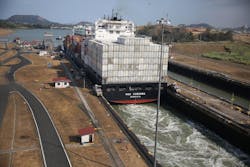Panama Canal: Freight boom or bust for East Coast trucking?
Over the past nine years, there has been a lot of speculation that expansion of the Panama Canal to accommodate larger ships would reshape the way goods move around the globe. The thought was East Coast ports and carriers were poised to benefit most from the expansion.
But Larry Gross, a partner and senior consultant at FTR, doesn’t exactly see it that way.
“There was discussion at some time that this was going to be a game changer,” Gross told Fleet Owner. “I don’t view it as a game changer.”
As of June 26, the $5.4 billion canal expansion project, which began in 2007, was complete and a third lane to accommodate ships that carry up to 14,000 containers, from the previous 5,000 containers, opened. The lane nearly triples the canal’s cargo capacity and allows mega container ships from Asia to come into the Eastern Seaboard.
The expansion comes amid a lull in global shipping, and with shipping rates already at rock bottom, analysts aren’t projecting a drastic shift in volume.
Currently most of the shipments into the U.S. from East Asia arrive at the ports of Los Angeles or Long Beach. However, a shift from West to East has been occurring for a number of years due to turmoil and labor disputes at West Coast ports, Gross explained.
He added that just because larger ships are available, doesn’t necessarily mean consumers will buy more goods from Asia going forward. In fact, Gross projects that there won’t be a significant shift in volume for the East Coast ports that can currently accommodate these larger ships.
“Volume will arrive in bigger chunks from a congestion standpoint, so there could be a lot of issues on the land side,” Gross explained. “There are a lot more peaks and valleys for the businesses and the ports.”
A lot of those peaks and valleys have to do with the East Coast ports and how they have been gearing up for the expansion. The biggest problem, Gross noted, is the port of New York and New Jersey, which is an integral part of the ship commodity on the East Coast. Three of the port’s four major terminals could accept the larger container ships, but they are on the wrong side of the Bayonne Bridge, which remains too low to accommodate these new titanic cargo ships. Though the bridge is being raised, that effort isn’t expected to be completed until 2017.
Some of the other ports on the east don’t have the required depth of 50 ft. to house the mega ships. Savannah is still in the process of dredging, and Charleston is not ready to accommodate the bigger ships, Gross said. Yet, the ports of Miami, Baltimore and Norfolk do have the depth, so it’s a mixed picture.
However, Georgia Ports Authority hails the expansion and projects big gains for the Port of Savannah. Last year, the Port of Savannah handled 8.2% of the U.S. containerized cargo volume and 10.3% of all U.S. containerized exports, the Authority reports.
“Industry experts estimate the larger ships now transiting the canal will provide savings of 20 to 40% per container slot, further increasing Savannah’s competitive advantage for all-water trade routes,” according to the Georgia Ports Authority.
Yet, another dilemma, according to The Journal of Commerce, is how shippers will balance the route through Panama with its canal tolls as well as longer transit times to the East Coast, against the shorter intermodal transits via the West Coast.
“The big question in the years ahead is whether the expanded Panama Canal will spur shippers to move more Asian imports through East and Gulf ports,” JOC said.
And there’s more bad news. A New York Times investigation has found that the “canal’s future is cloudy at best,” with its “safety, quality of construction and economic viability in doubt.” According to the report, in order to be successful, the new canal must have enough water, durable concrete, and locks big enough to accommodate the larger ships. However, the Times found it has failed to meet the expectations of all three.
The Times goes on to say that if the newly expanded canal doesn’t deliver as promised, “the consequences will be wide-ranging” as “American grain and soybean farmers and producers of liquefied natural gas, for example, may find it harder to sell to Asian customers,” according to the report. “Asian manufacturers may forsake the struggling ports on America’s East Coast for those in the West. Or they, and ultimately customers, will shoulder the added cost of going the long way around, through the Suez Canal.”
Overall, many are looking to see whether this $5-plus billion investment to expand the Canal will be worth it in the end.
“Billions of dollars have been invested with, I think, questionable benefits from a public standpoint,” Gross said. “But if you’re a port and you don’t do it, you’re dead. If the canal didn’t do this it would be obsolete because carriers wanted to go with big ships as well. It became a requirement to stay in the game.”
About the Author

Cristina Commendatore
Cristina Commendatore is a past FleetOwner editor-in-chief. She wrote for the publication from 2015 to 2023.
